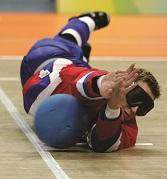
Editor’s Note: This year, Sports Destination Management will be featuring articles about planning sports events for athletes with special needs. The article in this issue, dealing with athletes with visual impairments, was contributed by the United States Association of Blind Athletes. Our next issue will discuss athletes with mobility impairments (those who use wheelchairs, walkers, crutches, etc.) We welcome articles and input from those in the industry who can share their experience in planning for those with other disabilities as well.
Event organizers must understand that athletes who have special needs will require extra assistance in a multitude of ways. The intricate logistical web of these events necessitates that planners make proper accommodations with sites, hotels, modes of transportation and volunteer knowledge of working with this population.

The Benefits of Offering Sports for Disabled Individuals
Through sports, athletes with visual impairments help to change society's negative stereotypes concerning the abilities of blind people as well as other disabled individuals. Combating stereotypes is achieved by both educating the public through various media avenues as well as by training athletes to enter schools and community organizations to directly address disability issues.
USABA, a member of the U.S. Olympic Committee, provides athletic opportunities in various sports, including track and field, Nordic and alpine skiing, biathlon, judo, wrestling, swimming, tandem cycling, powerlifting and goalball. Each sport represents a unique set of organizational obstacles but also has the potential to change the public’s perception of the blind.
Goalball is an excellent example, being the most distinctive of these sports for the blind. The game, first developed after World War II as a means to help visually impaired veterans in their rehabilitation efforts, is anomalous in that it relies on the tactile resources of hearing and touch; all participants wear darkened goggles, thereby negating any disadvantage to blind athletes and the ball has several bells embedded inside. These distinctions, coupled with the measurement of the court and the specifications for the playing surface, add to the challenge of preparing for goalball tournaments.
Special Playing Fields, Special Playing Conditions
The International Blind Sports Federation (IBSA) mandates that goalball fields of play reach 18 meters in length by 9 meters in width on a hard and glossy surface such as an indoor basketball or volleyball court. Two goals that span the width of the court are set in direct opposition of each other and three athletes compete on both sides. The court’s lines are composed of lengths of twine enveloped in tape, allowing the players to feel their way into position. Silence is needed during each interval of play so a degree of audience understanding is also essential.
 All levels of goalball competition—from the apex of the Paralympics to other international events, national championships and youth programs—require adherence to these rules. The organizational demands of the game are unchanging, regardless of who manages the event. Finding and securing the ideal location for a tournament becomes more and more difficult every year. At tournaments, each court must be distant enough to maintain seclusion of noise.
All levels of goalball competition—from the apex of the Paralympics to other international events, national championships and youth programs—require adherence to these rules. The organizational demands of the game are unchanging, regardless of who manages the event. Finding and securing the ideal location for a tournament becomes more and more difficult every year. At tournaments, each court must be distant enough to maintain seclusion of noise.
“Historically, teams and tournament organizers had relatively easy access to quality training and competitive facilities,” John Potts, USABA Goalball High Performance Manager, said. “But as budgets have tightened and security demands have increased, many traditional venue providers can no longer permit access or are now required to levy user fees that can run into thousands of dollars per activity.”
Volunteer Support Essential for Success
USABA, which fundraises and organizes international events throughout the United States for competitors of all ages and skills in 12 sports, is the high performance manager for goalball in the United States. The nonprofit organization works in partnership with United States Paralympics through the United States Olympic Committee to oversee the development of the sport at all levels. On the court, USABA also leans on a broad network of volunteers. Such a sturdy infrastructure of unpaid personnel eases the burdens of preparation and execution for any nonprofit organization.
“Even with the very best facilities, it's the many volunteers behind the scenes that I believe determine the success of any goalball program or competition,” Potts said. “The scope of what they do can range from coach to referee, fundraiser, or driver—sometimes the same performs most or all of these duties at the same time. I don't think we could have goalball without them and we can't thank them enough for what they do every day.”
The magnitude of organizing international events requires extensive planning. In July, USABA hosted the 2013 IBSA Pan American Games and 2013 IBSA World Youth Championships in Colorado Springs, Colo. During the weeklong competition, a conjoined event that also included a judo tournament, more than 200 goalball athletes from 13 nations played on three courts at the El Pomar Gymnasium on the campus of Colorado College. Since at least nine volunteers are needed to help officials run every goalball game—four on the court, five at the scorer’s table, at minimum—the process of training is always intensive.
Training Volunteers to be Effective
Each day at the 2013 IBSA Pan American Games and 2013 IBSA World Youth Championships, USABA educated groups of 25 to 30 volunteers in separate sessions for morning, afternoon and evening games. These unpaid personnel included men and women of all ages and athletic backgrounds, some of whom had little or no familiarity with the sport. Volunteer coordinators instructed on courtside roles and decorum as well as all the intricacies of the inimitable sport. Every volunteer must know how to interact with athletes who need assistance getting to and from the court.
Off the court or field of competition, it is essential to make athletes feel comfortable at all costs. Accessibility does not always mean that an event site is devoid of stairs or narrow hallways; volunteers and staff assist the athletes in every means possible, from guiding to the court or locker room or taking them to and from lodgings before and after competitions. Interpreters are also used for international events.
 Day-to-day interaction with blind and visually impaired athletes requires some foreknowledge. According to the website for VisionServe Alliance, an organization the focuses on improving the lives of people who are blind and visually impaired through education and charity, recommendations for meeting and greeting a blind person include speaking “directly to the person in a normal tone of voice;” making sure to “proceed at a normal pace” while guiding; being “explicit in giving directions,” avoiding vague descriptions and providing “compass directions or the position of the hands on a clock;” and to “never leave a person who is blind in an open area.”
Day-to-day interaction with blind and visually impaired athletes requires some foreknowledge. According to the website for VisionServe Alliance, an organization the focuses on improving the lives of people who are blind and visually impaired through education and charity, recommendations for meeting and greeting a blind person include speaking “directly to the person in a normal tone of voice;” making sure to “proceed at a normal pace” while guiding; being “explicit in giving directions,” avoiding vague descriptions and providing “compass directions or the position of the hands on a clock;” and to “never leave a person who is blind in an open area.”
Additional Aspects of Planning
Guide dogs are also an integral part of life for many people who are blind or visually impaired. Volunteers and staff are taught to use proper etiquette with these all-important pets. According to the VisionServe Alliance website, people must “remember that a guide dog is responsible for leading someone who cannot see and the dog should never be distracted from that duty;” that “a guide dog should never be offered food or other distracting treats, as the dogs are fed on a schedule and follow a specific diet to keep them in optimum condition;” and that “The Americans with Disabilities Act permits guide dogs to accompany their owners anywhere the general public is allowed.”
In addition, hotels and lodgings are sought based accommodating all of these factors. Each logistical issue is as important as the last in building the organizational framework of a successful event.

